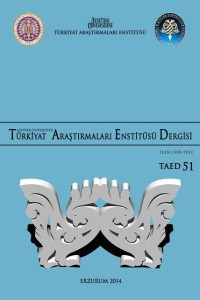Abstract
In this article were handled inscriptions Kalbak-Taş XX (A 43) and Kalbak-Taş XXI (A 44) which found in Alrai and have been suggested. Mountainous Altai in Article 43 of the calpain-Stone article (calpain-Stone XX) and 44 (calpain-Stone XXI) by discussing the new proposals on readings and meanings on this inscriptions. Is thought to be that the inscription Kalbak-Tash XXI which read and interpreted as „ig(e)n: b(e)z(e)g(e)li / b(e)z(e)gli: k(a)r(ı)m n(e) y(e)g (o)l:(e)ş(i)k b(e)n y(e)g (e)r (What better my hand that decorated the deers I am, Ahmet is good soldier)‟ associated with the inscription Kalbak-Tash XX which read and interpreted as „ig(e)n(i)g: b(e)d(i)zg(e)li: uz (e)rm(i)ş (He is skillful on to image deers)‟. So the person named Ahmet draw a three deer picture on the rock and he liked these pictures. This idea was expressed in the form of inscription. Then someone who visited here saw the pictures and read the inscription. He liked the pictures too and he attended to Eşik. After all he wrote the inscription where he said that Eshik is skillful on to image deers. This inscription in the form of a dialogue which contains everyday life events is important in terms of showing that the literacy rate and culture of writings of ancient Turkish is high
References
- Alyılmaz, C. (2005). Orhun yazıtlarının bugünkü durumu. Ankara: Kurmay Yayınevi.
- Kızlasov, İ. L. (2003). Novosti Tyurkskoy Runologii I, Yeniseyskiye Nadpisi Na Gore Yalbak- Taş (Gornıy Altay), Moskova.
- Klyaştornıy, S. G. (2005). Drevnetyurkskiye Runiçeskiye Pamyatniki Kak İstoriçeskiy İstoçnik, II. Uluslararası Türk Uygarlığı Kongresi Bildirileri, KTMÜ, Bişkek, s. 59-64.
- Koç, K., Bayniyazov, A. ve Başkapan, V. (2003). Kazak Türkçesi-Türkiye Türkçesi Sözlüğü, Türkistan.
- Kononov, A. N. (1980), Grammatika Yazıka Tyurkskih Runiçeskih Pamyatnikov (VII-IX vv.), Leningrad.
- Sertkaya, O. F. (2001). Eski Türkler okur yazar mıydı?, Göktürk Devletinin 1450. Kuruluş Yıl Dönümü-Sempozyum Bildirileri, Ankara, s. 23-37.
- Tekin, T. (2003). Orhon Türkçesi grameri, 2. basım, İstanbul.
- Tıbıkova, L. N., Nevskaya, İ. A. ve Erdal M. (2012). Katalog Drevnetyurkskih Runiçeskih Pamyatnikov Gornogo Altaya, Gorno-Altaysk.
- Useev, N. (2011). Yenisey Cazma Estelikteri I: Leksikası cana Tekstter, Bişkek.
- User, H. Ş. (2009). Köktürk ve Ötüken Uygur Kağanlığı Yazıtları, Söz Varlığı İncelemesi, Konya.
- Vasilyev, D. D. (1995). Dağlık Altaylardaki Kalbak-Taş mabedinin Göktürk yazıtları (A. 47, 48, 29, 50), Türk Dili Araştırmaları Yıllığı Belleten 1993, s. 91-97.
- Yudahin, K. K. (1985). Kirgizsko-Russkiy Slovar’ I, Frunze.
- Yazıtın Çizimleri ve Resimleri
- Resim 1: Kalbak-Taş XX (A 43) Yazıtının Çizimi
- Foto 1: Kalbak-Taş XX (A 43) Yazıtının görüntüsü
- Foto 2: Kalbak-Taş XX (A 43) Yazıtının görüntüsü
- Resim 2: Kalbak-Taş XXI (A 44) Yazıtının Çizimi
- Foto 3: Kalbak-Taş XXI (A 44) Yazıtının görüntüsü
- Foto 4: Kalbak-Taş XXI (A 44) Yazıtının görüntüsü
- Foto 5: Kalbak-Taş XXI (A 44) Yazıtının görüntüsü
Abstract
Makalede Dağlık Altay‟daki Kalbak-Taş yazıtlarından Kalbak-Taş XX (A 43) ve Kalbak-Taş XXI (A 44) yazıtları ele alınarak üzerinde yeni okuma ve anlamlandırma teklifleri ileri sürülmüştür. „ig(e)n: b(e)z(e)g(e)li / b(e)z(e)gli: k(a)r(ı)m n(e) y(e)g (o)l: (e)ş(i)k b(e)n y(e)g (e)r (Geyikleri bezemek için / bezeyen elim ne iyi! Eşik ben iyi erim)‟şeklinde okunan ve anlamlandırılan Kalbak-Taş XXI yazıtının „ig(e)n(i)g: b(e)d(i)zg(e)li: uz (e)rm(i)ş (Geyik (resimlerini) resmetmede ustaymış)‟ şeklinde okunan ve anlamlandırılan Kalbak-Taş XX yazıtı ile ilişkili olduğu düşünülmektedir. Yani Eşik adlı kişi yazıtlar bulunan kayaya üç geyik resmini çizmiş ve bu resimler hoşuna gitmiştir. Bunu da yazıt şeklinde belirtmiştir. Daha sonra burasını ziyaret eden birisi bu resimleri görmüş ve yazıtı okumuştur. Geyik resimleri onun da hoşuna gitmiş ve Eşik‟in dediklerine katılarak onun resim çizmede usta olduğunu yansıtan yazısını yazmıştır. Diyalog şeklindeki ve günlük hayatı içeren bu yazıtlar Eski Türklerde okur yazarlık oranının ve yazı kültürünün yüksek olduğunu göstermesi açısından önem kazanmaktadır.
References
- Alyılmaz, C. (2005). Orhun yazıtlarının bugünkü durumu. Ankara: Kurmay Yayınevi.
- Kızlasov, İ. L. (2003). Novosti Tyurkskoy Runologii I, Yeniseyskiye Nadpisi Na Gore Yalbak- Taş (Gornıy Altay), Moskova.
- Klyaştornıy, S. G. (2005). Drevnetyurkskiye Runiçeskiye Pamyatniki Kak İstoriçeskiy İstoçnik, II. Uluslararası Türk Uygarlığı Kongresi Bildirileri, KTMÜ, Bişkek, s. 59-64.
- Koç, K., Bayniyazov, A. ve Başkapan, V. (2003). Kazak Türkçesi-Türkiye Türkçesi Sözlüğü, Türkistan.
- Kononov, A. N. (1980), Grammatika Yazıka Tyurkskih Runiçeskih Pamyatnikov (VII-IX vv.), Leningrad.
- Sertkaya, O. F. (2001). Eski Türkler okur yazar mıydı?, Göktürk Devletinin 1450. Kuruluş Yıl Dönümü-Sempozyum Bildirileri, Ankara, s. 23-37.
- Tekin, T. (2003). Orhon Türkçesi grameri, 2. basım, İstanbul.
- Tıbıkova, L. N., Nevskaya, İ. A. ve Erdal M. (2012). Katalog Drevnetyurkskih Runiçeskih Pamyatnikov Gornogo Altaya, Gorno-Altaysk.
- Useev, N. (2011). Yenisey Cazma Estelikteri I: Leksikası cana Tekstter, Bişkek.
- User, H. Ş. (2009). Köktürk ve Ötüken Uygur Kağanlığı Yazıtları, Söz Varlığı İncelemesi, Konya.
- Vasilyev, D. D. (1995). Dağlık Altaylardaki Kalbak-Taş mabedinin Göktürk yazıtları (A. 47, 48, 29, 50), Türk Dili Araştırmaları Yıllığı Belleten 1993, s. 91-97.
- Yudahin, K. K. (1985). Kirgizsko-Russkiy Slovar’ I, Frunze.
- Yazıtın Çizimleri ve Resimleri
- Resim 1: Kalbak-Taş XX (A 43) Yazıtının Çizimi
- Foto 1: Kalbak-Taş XX (A 43) Yazıtının görüntüsü
- Foto 2: Kalbak-Taş XX (A 43) Yazıtının görüntüsü
- Resim 2: Kalbak-Taş XXI (A 44) Yazıtının Çizimi
- Foto 3: Kalbak-Taş XXI (A 44) Yazıtının görüntüsü
- Foto 4: Kalbak-Taş XXI (A 44) Yazıtının görüntüsü
- Foto 5: Kalbak-Taş XXI (A 44) Yazıtının görüntüsü
Details
| Primary Language | Turkish |
|---|---|
| Journal Section | Makaleler |
| Authors | |
| Publication Date | April 23, 2014 |
| Published in Issue | Year 2014 Issue: 51 |


